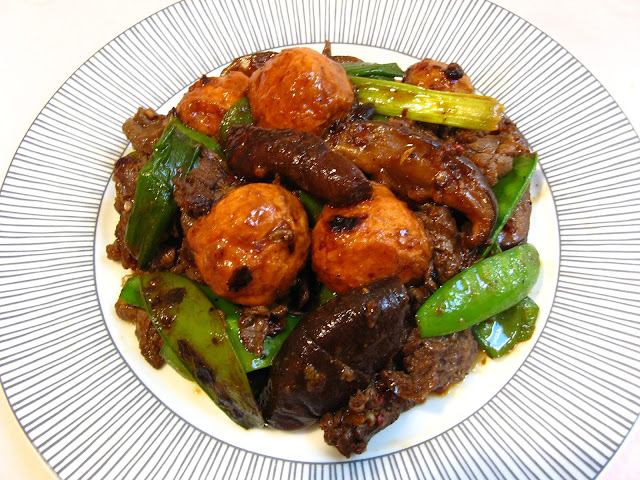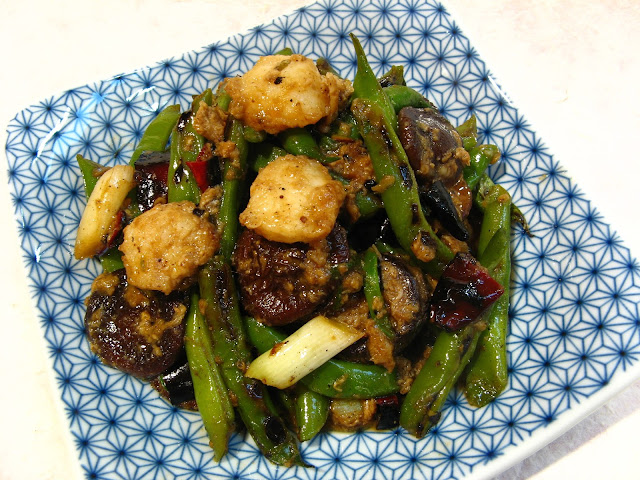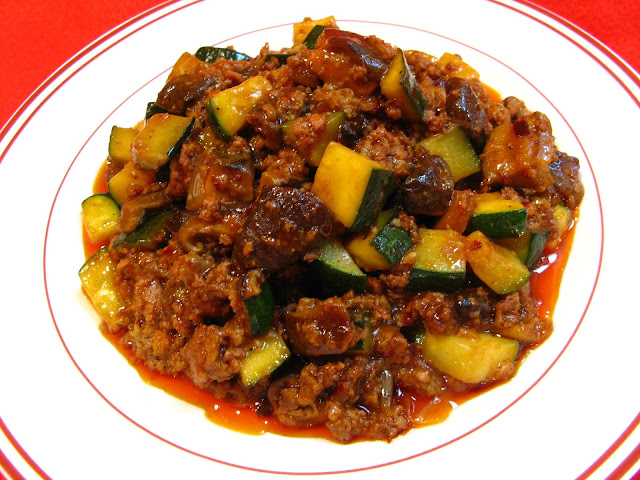My previous squid (only) recipes: Chili
Lemongrass Squid (辣椒檸檬葉魷魚, Laat6 Ziu1
Ning4 Mung4 Jip6 Jau4 Jyu4)
and Squid
In Salty Shrimp Sauce (蝦醬鮮魷, Haa1 Zoeng3
Sin1 Jau4), used frozen squid. Frozen squid is
convenient to use since they’re already cleaned and ready for cooking after
being thawed, and is always available (from the freezer). My local farmer’s
market had fresh squid (caught that morning in California’s Monterey Bay
according to the vendor), so I decided on the spot to buy and make a dish with
them. Fresh squid is available at my local Asian markets, but many times they’ve
been frozen (whole) and then thawed for sale. So, this squid was truly fresh!
Cleaning fresh squid is simple. Grasp the squid’s head and pull the tentacles and head, together with the quill and innards out in one motion. The quill is the only hard part of the squid and is inedible. Cut the tentacles away from the head, just below the eyes, and discard the head and innards. The tentacles are my favorite part of the squid to eat (I guess because of their texture). The squid’s body is in the shape of a cylinder, so open the cylinder with a long cut the length of the cylinder. Remove the outer skin from the squid’s body, score the outer part of the body with diagonal cuts, and then cut into edible pieces.
Enjoy!
Ingredients
|
2 lb.
|
1 kg.
|
Fresh squid (魷魚, jau4
jyu4), cleaned, scored, and cut into 2-inch (5 cm.) pieces
|
|
|
|
|
|
1 lb.
|
500 g.
|
Zucchini (意大利青瓜, ji3 daai6
lei6 ceng1 gwaa1), cut into 1-inch (2.5 cm.) diagonal
pieces
|
|
8
|
8
|
Dried Shiitake
mushrooms (冬菇, dung1
gu1), rehydrated and cut into quarters
|
|
8 oz.
|
227 g.
|
One package fried
tofu (油炸豆腐, jau4
zaa3 dau6 fu6)
|
|
8 oz.
|
227 g.
|
One 15 oz. (425
gm.) can baby corn (玉米尖, juk6
mai5 zim1), drained and cut into 2-inch (5 cm.) pieces
|
|
3 stalks
|
3 stalks
|
Green onions (葱, cung1), cut into ½-inch (15 mm.) pieces
|
|
|
|
Oil for cooking
|
Sauce Ingredients
|
2 Tbs.
|
30 ml.
|
Salted black beans (豆豉,
dau6 si6)
|
|
½ in.
|
15 mm.
|
Knob of ginger
(薑, goeng1), crushed in a garlic
press
|
|
2 cloves
|
2 cloves
|
Garlic (蒜, syun3), crushed in a garlic press
|
|
|
|
|
|
2 Tbs.
|
30 ml.
|
Soy sauce (豉油, si6
jau4)
|
|
1 Tbs.
|
15 ml.
|
Hoisin sauce (海鮮醬, hoi2
sin1 zoeng3)
|
|
2 Tbs.
|
30 ml.
|
Shaoxing rice wine (紹興酒,
siu6 hing1 zau2) or dry sherry
|
|
½ tsp.
|
2.5 ml.
|
Ground white pepper (白胡椒,
baak6 wu4 ziu1)
|
|
½ Tbs.
|
7.5 ml.
|
Sesame oil (麻油, maa4
jau4)
|
|
|
|
|
|
2 tsp.
|
10 ml.
|
Corn starch (粟粉, suk1
fan2)
|
|
4 tsp.
|
20 ml.
|
Water
|
Equipment
|
|
|
Garlic press
|
|
14 in.
|
35.5 cm.
|
Wok or pan
|
Preparation Instructions
 |
| Cleaned Squid Tentacles and Body |
- Cleaning fresh squid is simple. Grasp the squid’s head and pull the tentacles and head, together with the quill and innards out in one motion. The quill is the only hard part of the squid and is inedible. Cut the tentacles away from the head, just below the eyes, and discard the head and innards. The squid’s body is in the shape of a cylinder, so open the cylinder with a long cut the length of the cylinder. Remove the outer skin from the squid’s body, score the outer part of the body with diagonal cuts, and then cut into 2-inch (5 cm.) pieces.
- Pour boiling water over the small dried whole Shiitake mushrooms in a heat proof bowl and rehydrate the mushrooms for at least one hour. Remove the Shiitake mushrooms from the rehydration liquid and remove the stems. Cut the Shiitake mushrooms into quarter pieces. Reserve the rehydration liquid for later use in the cooking process. If you need to rehydrate the Shiitake mushrooms quickly, use the method described here: Technique: How to Quickly Rehydrate Dried Shiitake Mushrooms (冬菇, Dung1 Gu1).
- Wash and cut the zucchini into 1-inch (2.5 cm.) quarter-cut pieces. Cut the zucchini on the diagonal and turn the zucchini a quarter-turn. Repeat the diagonal cut and quarter-turn steps until the entire zucchini is cut into pieces.
- Open the fried tofu package and discard any liquid.
- Open the can of baby corn and discard any liquid. Cut the baby corn into 2-inch (5 cm.) pieces.
- Wash and cut the green onions into ½-inch (15 mm.) pieces.
- Wash and lightly crush the salted black beans in a small bowl. Crush the ginger and garlic in a garlic press, put into the bowl with the salted black beans, and mix the ingredients together.
- Prepare and mix the sauce in a small bowl: add the soy sauce, hoisin sauce, Shaoxing rice wine or dry sherry, ground white pepper, and sesame oil. In another small bowl, prepare the corn starch slurry by mixing the corn starch and water together.
Cooking Instructions
- Heat a wok or pan over high heat before adding oil. Add the squid to the wok in a single layer on the bottom and brown the outside. You may have to cook the squid in batches, so be sure to reheat the wok over high heat before adding more oil. Transfer the squid to a bowl.
- Reheat the wok over high heat before adding oil and then the Shiitake mushrooms. Stir fry the mushrooms and then transfer to the bowl with the squid.
- Reheat the wok over high heat before adding oil and then the fried tofu. Stir fry the fried tofu and then transfer to the bowl with the squid.
- Reheat the wok over high heat before adding oil and then the baby corn. Stir fry the baby corn and then transfer to the bowl with the squid.
- Reheat the wok over high heat before adding oil and then the bowl with the salted black bean mixture. Quickly stir fry the salted black bean mixture until it becomes fragrant. Add the zucchini to the wok and stir fry until browned. Add the contents of the bowl with the squid back into the wok, and stir fry all the ingredients together.
- Add the green onions and the sauce ingredients to the wok and stir fry the ingredients together. If more sauce is desired, add some of the mushroom rehydration liquid to the wok. Add the corn starch slurry to thicken the sauce and mix all the ingredients together. Put the cooked ingredients into a serving dish, and serve with Clay Pot Rice (煲仔飯, Bou1 Zai2 Faan6) or steamed rice.




















